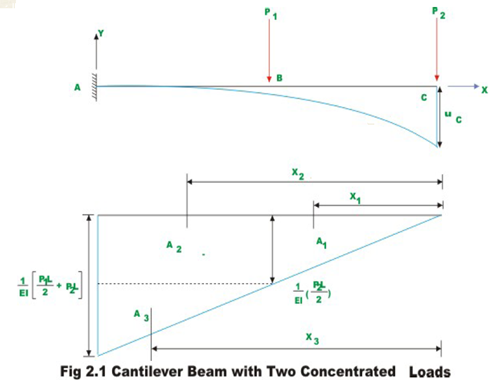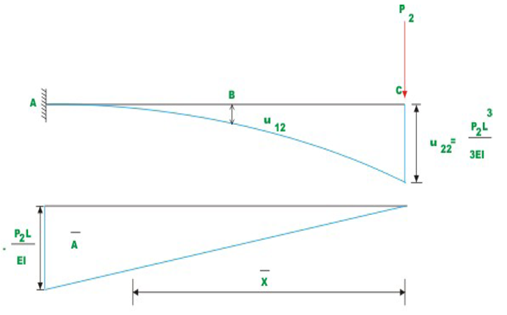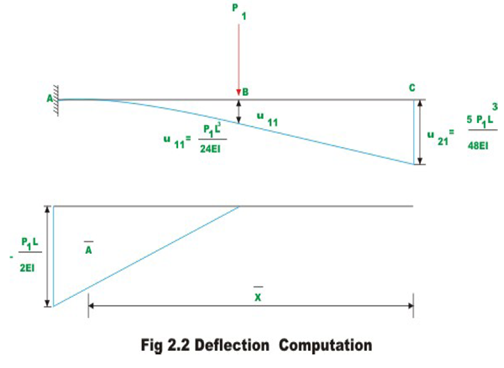The principle of superposition is a central concept in the analysis of structures. This is applicable when there exists a linear relationship between external forces and corresponding structural displacements. The principle of superposition may be stated as the deflection at a given point in a structure produced by several loads acting simultaneously on the structure can be found by superposing deflections at the same point produced by loads acting individually. This is illustrated with the help of a simple beam problem. Now consider a cantilever beam of length L and having constant flexural rigidity EI subjected to two externally applied forces P1 and P2 as shown in Fig.1. From moment-area theorem we can evaluate deflection below , which states that the tangential deviation of point from the tangent at point A is equal to the first moment of the area of the M/EI diagram between A and C about . Hence, the deflection below due to loads P1 and P2 acting simultaneously is (by moment-area theorem),

u=A1x1 +A2x2 +A3x3
where u is the tangential deviation of point C with respect to a tangent at A. Since, in this case the tangent at A is horizontal, the tangential deviation of point C is nothing but the vertical deflection at C. x1,x2 and x3are the distances from point C to the cancroids of respective areas respectively.

Hence

After simplification one can write,

Now consider the forces being applied separately and evaluate deflection at in each of the case.



where u22 is deflection at C(2) when load P1 is applied at (2) itself. And,

where u21 is the deflection at C(2) when load is applied at B(1). Now the total deflection at C when both the loads are applied simultaneously is obtained by adding u21 and u22

Hence it is seen from equations (2.3) and (2.6) that when the structure behaves linearly, the total deflection caused by forces P1,P2,P3,....Pn at any point in the structure is the sum of deflection caused by forces acting P1,P2,P3,....Pn independently on the structure at the same point. This is known as the Principle of Superposition.
The method of superposition is not valid when the material stress-strain relationship is non-linear. Also, it is not valid in cases where the geometry of structure changes on application of load. For example, consider a hinged-hinged beam-column subjected to only compressive force as shown in Fig. 2.3(a). Let the compressive force P be less than the Euler’s buckling load of the structure. Then deflection at an arbitrary point C uc1 is zero. Next, the same beam-column be subjected to lateral load Q with no axial load as shown in Fig. 2.3(b). Let the deflection of the beam-column at C uc2 be . Now consider the case when the same beam-column is subjected to both axial load and lateral load. As per the principle of superposition, the deflection at the centre uc3 must be the sum of deflections caused by P and Q when applied individually. However this is not so in the present case. Because of lateral deflection caused by Q, there will be additional bending moment due to at C.Hence, the net deflection uc3 will be more than the sum of deflections uc1 and uc2.
The method of superposition is not valid when the material stress-strain relationship is non-linear. Also, it is not valid in cases where the geometry of structure changes on application of load. For example, consider a hinged-hinged beam-column subjected to only compressive force as shown in Fig. 2.3(a). Let the compressive force P be less than the Euler’s buckling load of the structure. Then deflection at an arbitrary point C uc1 is zero. Next, the same beam-column be subjected to lateral load Q with no axial load as shown in Fig. 2.3(b). Let the deflection of the beam-column at C uc2 be . Now consider the case when the same beam-column is subjected to both axial load and lateral load. As per the principle of superposition, the deflection at the centre uc3 must be the sum of deflections caused by P and Q when applied individually. However this is not so in the present case. Because of lateral deflection caused by Q, there will be additional bending moment due to at C.Hence, the net deflection uc3 will be more than the sum of deflections uc1 and uc2.
